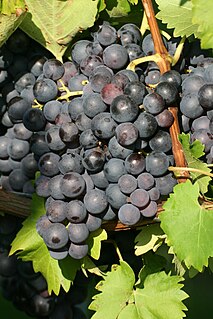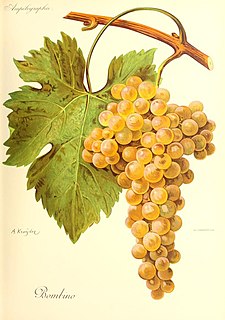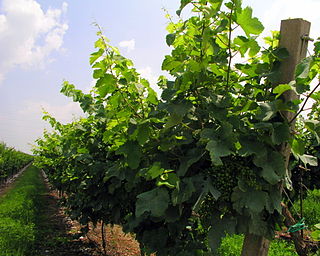Related Research Articles

Verdicchio is a white Italian wine grape variety grown primarily in the Marche region of central Italy. The name Verdicchio derives from verde and refers to the slight green/yellow hue that wines made from the grape can have.

Trollinger, Schiava, or Vernatsch, is a red German/Italian wine grape variety that was likely first originally cultivated in the wine regions of South Tyrol and Trentino, but today is almost exclusively cultivated on steep, sunny locations in the Württemberg wine region of Baden-Württemberg. It is primarily known under the synonyms Trollinger in Germany, Vernatsch in South Tyrol and Schiava in other Italian regions. As a table grape the variety is sometimes known as Black Hamburg, which is commonly confused with the similar synonym for Black Muscat—a variety that is actually a cross of Trollinger and Muscat of Alexandria.

Vermentino is a light-skinned wine grape variety, primarily found in Italian wine. It is widely planted in both Sardinia and Liguria, to some extent in Corsica, in Piedmont under the name Favorita, and in increasing amounts in Languedoc-Roussillon. The leaves are dark green and pentagonal. The grapes are amber-yellow and hang in pyramidal bunches. The vines are often grown on slopes facing the sea where they can benefit from the additional reflected light. The Vitis International Variety Catalogue now gives Italy as its origin.

Canaiolo is a red Italian wine grape grown through Central Italy but is most noted in Tuscany. Other regions with plantings of Canaiolo include Lazio, Marche and Sardegna. In Umbria a white berried mutation known as Canaiolo bianco exists. Together with Sangiovese and Colorino it is often used to create Chianti wine and is an important but secondary component of Vino Nobile di Montepulciano. In the history of Chianti it has been a key component blend and during the 18th century may have been the primarily grape used in higher percentage than Sangiovese. Part of its popularity may have been the grape's ability to partially dry out without rotting for use in the governo method of prolonging fermentation. In the 19th century, the Chianti recipe of Bettino Ricasoli called for Canaiolo to play a supporting role to Sangiovese, adding fruitiness and softening tannins without detracting from the wine's aromas. In the aftermath of the phylloxera epidemic, the Canaiolo vines did not take well to grafting onto new American rootstock and the grape began to steadily fall out of favor. As of 2006, total plantings of Canaiolo throughout Italy dropped to under 7,410 acres. Today there are renewed efforts by Tuscan winemakers to find better clonal selections and re-introduce the variety into popular usage.

Montepulciano is a red Italian wine grape variety that is most noted for being the primary grape behind the DOCG wines Offida Rosso, Montepulciano d'Abruzzo, Montepulciano d'Abruzzo Colline Teramane, Rosso Conero and the DOC wine Rosso Piceno Superiore.
Greco is an Italian wine grape that may be of Greek origin. The name relates to both white (Greco bianco) and black (Greco nero) grape varieties. While there is more land area dedicated to Greco nero, the Greco bianco is the grape most commonly referred to by "Greco". In the Campania region it is used to produce the Denominazione di Origine Controllata e Garantita (DOCG) wine Greco di Tufo. In Calabria, it is used to make the Denominazione di Origine Controllata (DOC) wine Greco di Bianco. The name "Greco" is sometimes used as a synonym for several varieties of supposed Greek origins-most notably Trebbiano.

Fiano is a white Italian wine grape variety that is grown primarily in the Campania region of southern Italy and on the island of Sicily. In Campania, this fairly strong flavored white wine grape is particularly noted around Avellino where the Denominazione di origine controllata e Garantita (DOCG) wine of Fiano di Avellino is produced. The grape has a long history in the Campanian region and is believed to have been the grape behind the ancient Roman wine Apianum. Even today, the name Apianum is permitted to appear on wine labels of the DOCG wine Fiano di Avellino.
Verdeca is a white Italian wine grape variety that is primarily grown in Apulia in southern Italy where ampelographers believe that the grape may have originated. In Apulia, it is one of the main grapes in the Denominazione di origine controllata wines of Locorotondo DOC and Martina Franca DOC along with Bianco d'Alessano. In Campania, it is grown on the slopes of Mount Vesuvius where it used as a blending variety with Falanghina, Coda di volpe and Greco in both the white wines and the sweet dessert wine of the region, Lacryma Christi. It is also a minor component used in the some vermouth production.

Bombino bianco is a white Italian wine grape variety planted primarily along Italy's Adriatic coast line, most notably in Apulia. The vine is prone to high yields and often produces neutral flavor wines. The grape is known under many synonyms throughout Italy including Debit and Pagadebit, names which came from the grape's reputation for being a high yielding and reliable crop for vineyard owners to grow that would assure them that on each vintage they could pay off their debts.

Vespaiola is a white Italian wine grape variety planted primarily in the Veneto region of northeastern Italy, where it is often dried to produce passito style dessert wines. Along with Friulano, Vespaiola is an important component in the Denominazione di origine controllata (DOC) white wine of Breganze produced in the province of Vicenza.
Uva Rara is a red Italian wine grape variety that is grown in the Piedmont and Lombardy wine regions of northern Italy. The grape is a permitted blending variety along with Nebbiolo in the Denominazione di Origine Controllata e Garantita (DOCG) wines of Ghemme. In the Denominazione di Origine Controllata (DOC) wine region of Oltrepò Pavese the grape is often blended with Barbera and Croatina. While Uva Rara's name means "rare grape" in Italian, the variety is actually widely planted with 608 hectares of the vine recorded in Italy in 2000.
Bombino nero is a red Italian wine grape variety that is grown in southern Italy, particularly the regions of Apulia, Basilicata, and Lazio, as well as on the island of Sardinia. It is a permitted grape variety in the Denominazione di origine controllata (DOC) wines of Castel del Monte and Lizzano. The grape is primarily a blending grape but it can also be used as a varietal for red and rosé wines. Though DNA evidence has shown that Bombino nero is not a dark-berried color mutation of the similarly named Bombino bianco, ampelographers still believe that the two varieties are related in some way.

Glera, also known as Prosecco, is a white variety of grape of Slovenian origin, which was brought to the Italian village of Prosecco from the Karst region. The variety was formerly mostly referred to as Prosecco, but in the EU was renamed "Glera" in 2009 to make room for the protection of "Prosecco" as the name of the Italian geographically-protected wine.

Albarola is a white Italian wine grape variety grown in the northwest Italy. It is most commonly found in the Liguria region where producers in the Cinqueterre Denominazione di origine controllata (DOC) use it as a blending component. Wine expert Jancis Robinson describes the wine made from Albarola as fairly "neutral" in profile. Outside of Liguria, the grape was historically grown in Sicily but for most of the 20th century has been declining in plantings along with other ancient Sicilian varieties like Albanello, Damaschino, Minella bianca and Montonico bianco.
Fortana is a red Italian wine grape variety grown primarily in the Emilia–Romagna region of northern Italy. A permitted grape variety in several Denominazione di origine controllatas (DOCs), mostly in Emilia, Fortana mostly contributes tartness and acidity in red blends.
Maceratino is a white Italian wine grape variety that is grown predominantly in the Marche along the Adriatic coast of Italy. Ampelographers believe the grape may have some relation to Greco and Verdicchio, as evidence by the several overlapping synonyms, but no definitive link has been proven. For most of the 20th century, and into the 21st century, plantings of Maceratino have been declining and becoming increasingly rare.

Nosiola is a white Italian wine grape variety that is grown in the Trentino region north of Lake Garda in the Valle dei Laghi. Here it is used in varietal Denominazione di origine controllata (DOC) wines and as a blending component in wines such as Sorni Bianco from Trento. It is also used to produce a dessert wine in the Vin Santo style from grapes that have been allowed to dry out prior to fermentation.
Mantonico bianco is a white Italian wine grape variety that is grown in the Calabria region of southern Italy. Ampelographers believe that the grape is likely of Greek origins and was transported to southern Italy by ancient Greek settlers. Though the variety has a long history in Calabria, its numbers have been slowly declining with 1100 hectares/2700 acres planted in the region by the end of the 20th century.
Forastera is a white Italian wine grape variety that is grown on the islands of Ischia and Procida off the coast of Naples in Campania. In the early 21st century, DNA analysis confirmed that the Spanish wine grape variety of the same name grown in the Canary Islands is a completely different and distinct variety with no close genetic relationship to the Italian Forastera.
Bonamico is a red Italian wine grape variety that is grown in the province of Pisa in Tuscany where the grape has a reputation for producing very high yields. Some ampelographers speculate that the grape may have originated around the town of Palaia with the grape being known under the synonym of Uva di Palaia. While often used as a table grape, Bonamico can be a minor blending component in several Tuscan Denominazione di Origine Controllata (DOC) and Indicazione Geografica Tipica (IGT) wines where it often contributes floral aroma notes and acidity.
References
- ↑ J. Robinson Jancis Robinson's Guide to Wine Grapes pg 29 Oxford University Press 1996 ISBN 0-19-860098-4